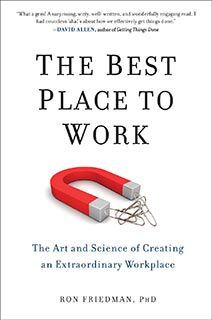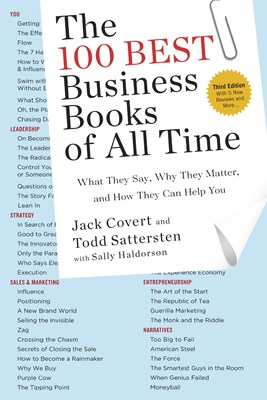The Best Place to Work by Ron Friedman Ph.D.
December 19, 2014
Psychologist Ron Friedman looks at the data on great workplaces and shows us that some hot trends are no better than the old assumptions they replaced.

The Best Place to Work: The Art and Science of Creating an Extraordinary Workplace by Ron Friedman, PhD; Perigree, 352 pages, $25.00, Hardcover, December 2014, ISBN 9780399165597
As a relatively new leader of a 15-person organization, I naturally gravitate to business books that help me further contemplate or even answer what I find to be some of the most intriguing questions about leadership. One of those questions is: what kind of company do we want to be? And certainly I am thinking first of both the product and the service that we offer, but I’m also thinking about our company in terms of employment: what kind of employer do we want to be? The question is actually quite deeply layered, despite the apparent simplicity of the answer: we want to offer employees the best place to work. But what is that exactly, and how do we do that with the internal and external constraints that exist in any company?
Ron Friedman’s new book, The Best Place to Work, orients instead toward the social sciences, and applies academic research, humanistic management principles, and innovative multi-disciplinary solutions to the contemporary workplace. If places like casinos and Target stores can apply theories of human behavior to impel people to spend more money, then certainly leaders should consider what motivates and energizes the people who do the work within an organization. Friedman explains, “In today’s knowledge economy, it’s the quality of your thinking that matters most, and quality thinking is directly tied to energy level.” A workplace that offers more drudgery than delight can certainly impair its overall success. Friedman explains:
A related argument can be made for the growing importance of maintaining a positive mood. In a world in which most jobs involve building interpersonal connections and fostering collaborations, feeling irritable can have serious implications for performance.
And the best thing about Friedman’s advice is that he isn’t simply trying to convince leaders to offer progressive perks—such as unlimited vacation, dogs and/or babies welcome in the office, and gifting employees to use corporate frequent flyer miles—that are all the rage these days. After all, while perks and “rah-rah-ism” can certainly be enjoyable, they do have a certain shelf life, and cannot make up for other areas where organizations fail their employees. Speaking of feedback, he notes:
Receiving excessive positive feedback is just as bad as having no feedback at all. When everything we do is celebrated, we lack the data we need to adjust our behaviors and build our skills, which interferes with our experience of competence.
Friedman, instead, encourages leaders to provide employees what they need in order to be productive and high-performing… every day. Immediate and specific feedback of positive behaviors, acknowledged publically, and perhaps even offered by peers instead of managers.
Other insights that Friedman presents include: instead of simplifying work down to rote and repetitive tasks, make sure your employees are consistently presented with new challenges that push them just a bit further than they had previously gone, whether that includes new responsibilities, new training, or just the opportunity to pursue a hobby: this again builds confidence and competence more than efficiency and accuracy would ever do.
One short section I found particularly interesting was subtitled “The Building Blocks of Pride,” and Friedman sets the stage:
It’s a curious disconnect. We spend almost half our waking hours working in companies that finance our livelihood, grow our skills, and bind us to many of our closest friends. Yet we rarely display even a fraction of the enthusiasm for our organizations as we do for groups that often play far less prominent roles in our lives.
His solutions include, establishing a “grand narrative” that centers upon future goals but also the company’s history, relishing in “group distinctiveness” that can be articulated through company culture, and generosity and altruism both inside and outside of the workplace.
The Best Place to Work explains that the very best places to work are those that take care of their employees, not always through such celebrated ways as holding ping pong tournaments once a month and advocating employees to take naps at mid-day, but through facilitating employee engagement via some well-researched and easy to execute internal behavioral changes that any leader can implement, regardless of the economic or cultural constraints of the business.
Sally Haldorson is 800-CEO-READ’s General Manager, and in-house editor of The 100 Best Business Books of All Time.


